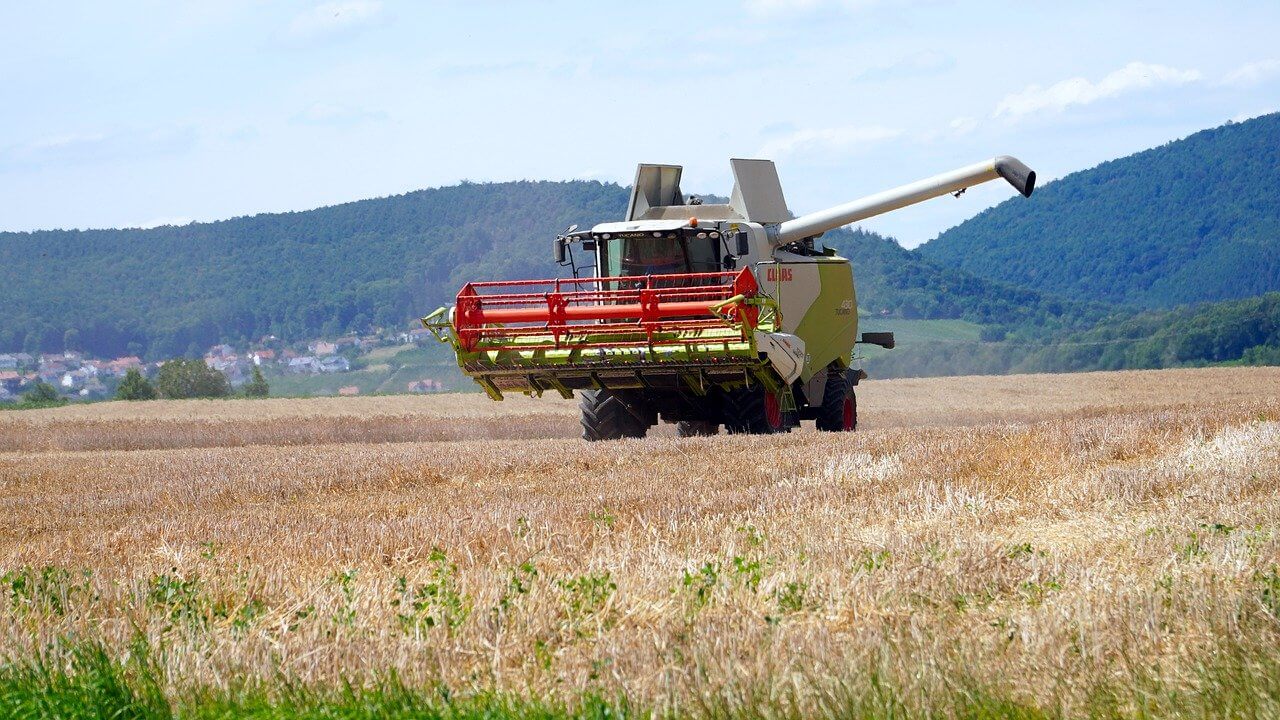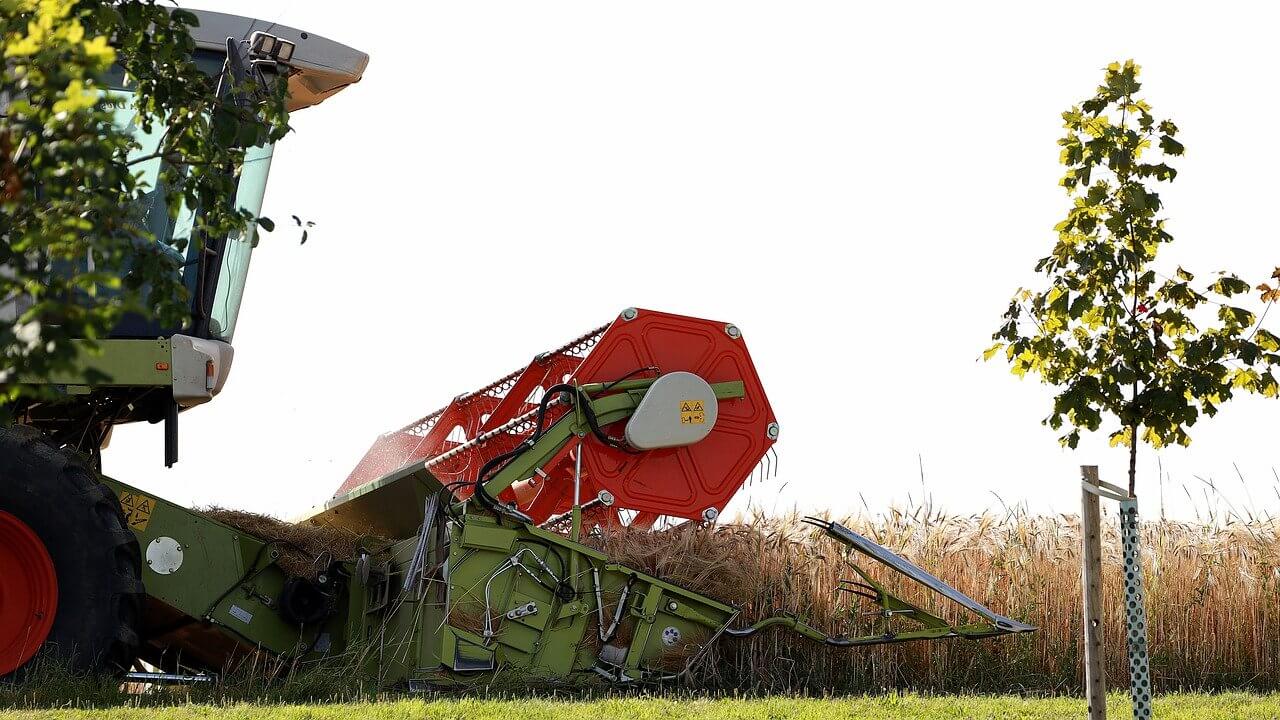A combine can be a very useful addition to your machinery set, particularly if your farm exceeds certain size and if you focus on certain crops. But what different types of combine harvester are there?
In this article, we also provide specific information and tips to help you make the right choice when purchasing a used combine. Read on to learn more.
What You'll Learn Today
Different Types Of Combine Harvester

There are essentially two types of combine harvesters they are:
1. Control combine harvester
This type of combine harvester is also called a tractor pull combine. You may also hear referred to as a pull type harvesting combine or a tractor combine. As these names imply, this type of combine does not move forward under its own power.
Instead, it is pulled by a tractor and its functions:
- Threshing
- Cutting
- Separating
- Cleaning
..are powered by the tractor’s takeoff shaft. Although this type of combine is less used, it is still in demand in some farming situations.
There are also control combine harvesters that are only pulled by a tractor and have their own separate engine to power their tasks. These types are not often used.
2. Self-propelled combine harvester
This type of combine harvester is most popular and most often used in today’s modern farm. This all-in-one variety of combine powers itself with its own attached engine. The engine performs two functions, powering the machine and also powering all of the operations related to harvesting. Self-propelled combine harvesters come in two varieties:
- Conventional combine harvester is made up mainly of the machine’s threshing system and its straw walkers.
- Axial flow or rotary combine harvester is made up mainly of the axial flow threshing system. This is the most popular type of self-propelled combine harvester.
What Are The Parts Of A Combine Harvester?
On any combine harvester you will find these parts:
- The chassis is made up of the engine, fuel tank, wheels, ground power train and the steering mechanism.
- The combine header is attached to the front of the combine and collects the grain.
- The threshing unit does the work of separating grain from vegetation.
- Separating straw walkers separate the grain from chaff, which may be made up of bits of vegetation, dirt, insects or any other thing you might not want mixed in with your grain.
- The cleaning system conveys the cleaned grain into the grain storage tank and blows chaff out the back of the machine.
- Naturally, the combine also needs a place for the operator to sit and work. This is the cab where you will find:
- Seat
- Driving Control
- Instrumentation
- Process Control Console
- Climate Control System
How Much Does A Combine Weigh?
Different brands of combines have different specifications and different weights. Here are the specifications of some of the more popular brands:
1. John Deere S690 is a very popular offering from one of the most experienced manufacturers of agricultural machinery. This heavy-duty machine makes short work of dense, heavy crops while exhibiting exemplary performance in terms of speed and maneuverability. This machine’s weight (without headers) is 15,636 kg.
2. The Claas Lexion 780 is a popular German brand that exhibits exemplary performance and is popular across five continents. This machine is touted as being eco-friendly due to its environmentally advanced engine. Gleaning performance is enhanced by the fact that the sieve positions and fan speed adjust automatically as the machine moves over variable terrain. This machine weighs (without headers) 18,920 kg.
3. The Claas Lexion 795 is a more recent iteration of Claas machines. This limited edition machine stands out due to its unusual green and black paint job and its informal moniker “Monster Limited Edition”. This machine is similar in weight and other specifications to the 780, but it is touted as being superior in performance.
4. Case IH 9240 is a beautifully designed machine that is the most productive and powerful offering from Case manufacturing. It offers superior grain handling and the highest measured unload rate of modern combines. This machine (without headers) weighs 19,144 kg.
5. New Holland CR 10.90 is listed by the Guinness Book of World Records as being the most powerful and largest wheat harvest combine. This gigantic machine moves smoothly thanks to independently operating hydraulic suspension rollers and an extended track length. It is the number one choice for large agricultural farm use and provides consistently superior harvesting and threshing results even under unfavorable weather conditions. This giant machine (without headers) weighs 24,600 kg.
6. Claas Lexion 8900 is even larger and is actually the largest combine harvester worldwide, and it outperforms the new Holland in terms of separation efficiency and percentage of threshed grain. It’s grain tank is also larger than that of the New Holland. This machine (without headers) weighs 22,400 kg.
How Much Does A Combine Harvester Cost?

It can be expensive to purchase a combine if you are buying new. In fact, a new combine may set you back anywhere between $330,000 and $500,000 , but a used combine may only cost between $5,900 and $450,000. On average, a used machine should be priced at around $122,200.
That’s why lots of farmers make the smart decision to purchase a used combine instead of a new one. As with any vehicle or machinery, if you take your time and shop smart, you can get just as much use and value out of a used combine as you would a new one.
The price you pay for a used combine depends on a number of factors, such as:
- Make and model
- Machine hours
- Age
The Price Of A Used Combine Harvester
A combine is an expensive piece of equipment and a big investment for a farmer. A new combine can end up costing far more than it’s worth to a small farmer. Luckily, in the used combine market, there is no shortage of options and choices.
When you go combine shopping, you will find many like-new choices, along with quite a few older machines with very high hours. You will also have your choice of machines offering bare basics and those offering extra features and add-ons.
All of these differences will be reflected in the asking price. Take these questions into account when looking for a used combine.
1. How do total engine hours affect combine price?
The more total engine hours a combine clocks, the lower the price will be. A machine with a thousand machine hours might cost you around $175,000. On the other hand, the same machine clocking three-thousand total engine hours could cost you only $50,000.
2. How does model year affect combine price?
Just as with used cars, the older a combine is, the less it will cost; however, you will find the difference between used and new is much greater on newer models than on older models.
3. How does brand affect combine prices?
- John Deere is the most popular brand of farm machinery, and their used combines are typically a bit higher priced than other used combines. A used John Deere will typically cost you between $12,500 to $376,690, with an average used cots of around $138,315.
- CLAAS was originally partnered with Caterpillar but now stands alone. These reliable machines are a bit pricey at $55,000 to $450,000 used. On average, you’ll pay about $156,208 for a second-hand CLAAS.
- Case IH is also quite popular in the United States, with a slightly higher than average second-hand price because of their axial flow features. Used, these combines can cost between $12,500 and $399,900, with an average cost of around $135,167.
- New Holland is popular because of its twin rotor design, which has been in place since 1975 and has been improved upon ever since. Generally speaking, you can expect to pay between $18,000 and $309,000 for a second-hand New Holland machine. On average, these combines cost about $124,754 used.
- Massey Ferguson has manufactured self propelled combines since 1938, and their product has just gotten better and better since that time. Even so, a used model of this sort is typically lower priced than some of the more popular types. A used Massey Ferguson will set you back between $5,900 and $259,500. On average, you can expect to pay around $102,585 for a used machine.
- Gleaner is another model whose used price is generally lower than that of other models of combines. A subsidiary of AGCO, this brand has been in business since 1923 and is well known for their manufacture of transverse rotary combines. You can buy a used Gleaner for anywhere between $6,550 and $259,000. On average, you’ll pay about $80,015.
I need a rice combine harvester
Good Morning Sir
I need used combine for maiz and rice,so please send me price with hours meter ,and both side pictures ,3 to 4 mtr cutter bar
We need John Deere brand used combine S680,S670, Please feel free to contact us by email or Whatsapp
korsiheater@gmail.com
whatsapp 008613944176278
I need a used combine harvester from Massey Ferguson, with meter hours and the lowest cost with pictures from all sides pls.
Pls contact me on
Serrengkat@yahoo.com
WhatsApp+2348037327951